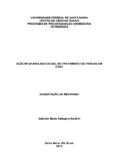| dc.creator | Serafini, Gabriele Maria Callegaro | |
| dc.date.accessioned | 2017-06-06 | |
| dc.date.available | 2017-06-06 | |
| dc.date.issued | 2012-02-27 | |
| dc.identifier.citation | SERAFINI, Gabriele Maria Callegaro. Granulated sugar and sugar gel in treating canine wounds. 2012. 51 f. Dissertação (Mestrado em Medicina Veterinária) - Universidade Federal de Santa Maria, Santa Maria, 2012. | por |
| dc.identifier.uri | http://repositorio.ufsm.br/handle/1/10117 | |
| dc.description.abstract | Sugar is one of the most widely used products in the treatment of wounds in veterinary medicine. Its main advantage is the hygroscopic effect on tissues and the bacterial death by plasmolysis, making it a bactericidal agent due to the physical effect observed, without leading to bacterial resistance as it might occur with antibiotic therapy. The objective of this experiment was to compare cicatricial evolution in cutaneous wounds with the topical use of sugar both granulated and in the form of a gel. For such, 16 canine wounds were treated, where eight received treatment with granulated sugar (group A) and eight with sugar gel (group G). Evaluations such as mensurations of the wounded areas, bacteriological cultures and observation of the aspect of the lesions were done weekly from the moment of the first examination until the formation of enough granulation tissue to suspend the use of the products. When comparing the decline in the area between groups no statistical difference was observed at any time. However, when the areas were analyzed in each group's interval, it was possible to notice a statistically significant decline between days 1-14 and 7-14 in the group treated with sugar. In the group treated with the gel, beside those intervals, a significant decline was also noticed between days 1-7. In terms of the frequency of negative bacteriological culture, there was no statistical difference between groups, not even in the different moments of each group. The time taken for the granulation tissue to be fully formed varied from 7 to 14 days in both groups. As to applicability, the gel showed better adhesion to the wounds and filling of the product subcutaneously more effectively than the granulated sugar. The conclusion reached is that both the sugar and the gel were effective in healing the animals' wounds in this experiment, the gel having demonstrated precocity in cicatricial retraction in the first seven days. | eng |
| dc.description.sponsorship | Coordenação de Aperfeiçoamento de Pessoal de Nível Superior | |
| dc.format | application/pdf | por |
| dc.language | por | por |
| dc.publisher | Universidade Federal de Santa Maria | por |
| dc.rights | Acesso Aberto | por |
| dc.subject | Cicatrização | por |
| dc.subject | Lesões cutâneas | por |
| dc.subject | Resistência bacteriana | por |
| dc.subject | Wound healing | eng |
| dc.subject | Cutaneous wounds | eng |
| dc.subject | Bacterial resistance | eng |
| dc.title | Açúcar granulado ou gel no tratamento de feridas em cães | por |
| dc.title.alternative | Granulated sugar and sugar gel in treating canine wounds | eng |
| dc.type | Dissertação | por |
| dc.description.resumo | O açúcar é um dos produtos mais utilizados para tratamento de feridas em medicina veterinária. Sua principal vantagem é o efeito higroscópico nos tecidos e morte das bactérias por plasmólise, tornando-o um bactericida pelo efeito físico realizado, sem levar à resistência bacteriana, como poderia ocorrer na terapia antibiótica. O objetivo desse experimento foi comparar a evolução cicatricial de feridas cutâneas com o uso tópico de açúcar na forma granulada e na forma de gel. Para tal, foram tratadas 16 feridas de cães, onde oito receberam tratamento com açúcar granulado (grupo A) e oito com gel de açúcar (grupo G). Avaliações como mensurações das áreas das feridas, culturas bacteriológicas e observação quanto ao aspecto das lesões foram realizadas semanalmente desde o momento do atendimento até a formação de tecido de granulação suficiente para suspender o uso dos produtos. Na comparação da diminuição da área entre os grupos não se observou diferença estatística em nenhum momento. Entretanto, quando as áreas foram analisadas nos intervalos de cada grupo, pôde-se perceber diminuição estatisticamente significativa entre os dias 1 e 14 e 7 e 14 no grupo tratado com açúcar. No grupo tratado com gel, além desses intervalos, também se percebeu diminuição significativa entre os dias 1 e 7. Com relação a frequência de cultura bacteriológica negativa, não houve diferença estatística entre os grupos, nem nos diferentes momentos de cada grupo. O tempo para completa formação de tecido de granulação variou entre sete e 14 dias em ambos os grupos. Quanto à aplicabilidade, o gel demonstrou melhor adesão nas feridas e preenchimento do produto no subcutâneo de forma mais efetiva que o açúcar granulado. Conclui-se que tanto o gel quanto o açúcar foram efetivos na cicatrização das feridas dos animais desse experimento, sendo que o gel demonstrou precocidade na retração cicatricial nos primeiros sete dias. | por |
| dc.contributor.advisor1 | Schossler, Joao Eduardo Wallau | |
| dc.contributor.advisor1Lattes | http://buscatextual.cnpq.br/buscatextual/visualizacv.do?id=K4784154D8 | por |
| dc.contributor.referee1 | Aguiar, Eduardo Santiago Ventura de | |
| dc.contributor.referee1Lattes | http://buscatextual.cnpq.br/buscatextual/visualizacv.do?id=K4761469D6 | por |
| dc.contributor.referee2 | Amaral, Anne Santos do | |
| dc.contributor.referee2Lattes | http://buscatextual.cnpq.br/buscatextual/visualizacv.do?id=K4728321T9 | por |
| dc.creator.Lattes | http://lattes.cnpq.br/2141190607166978 | por |
| dc.publisher.country | BR | por |
| dc.publisher.department | Medicina Veterinária | por |
| dc.publisher.initials | UFSM | por |
| dc.publisher.program | Programa de Pós-Graduação em Medicina Veterinária | por |
| dc.subject.cnpq | CNPQ::CIENCIAS AGRARIAS::MEDICINA VETERINARIA | por |


